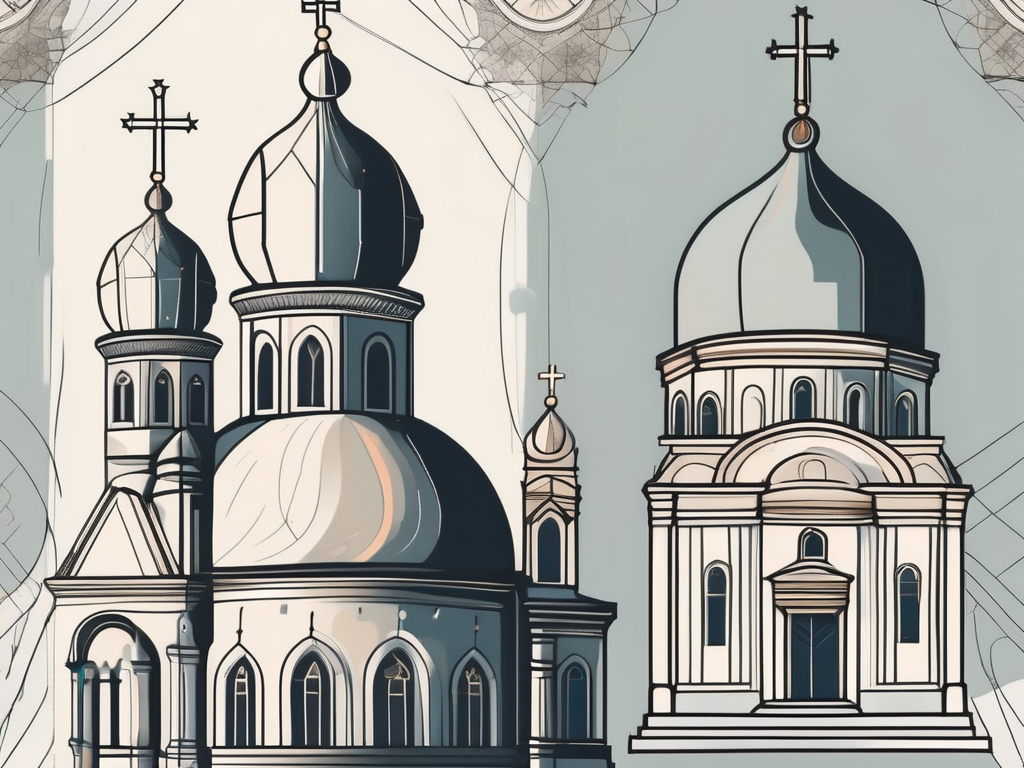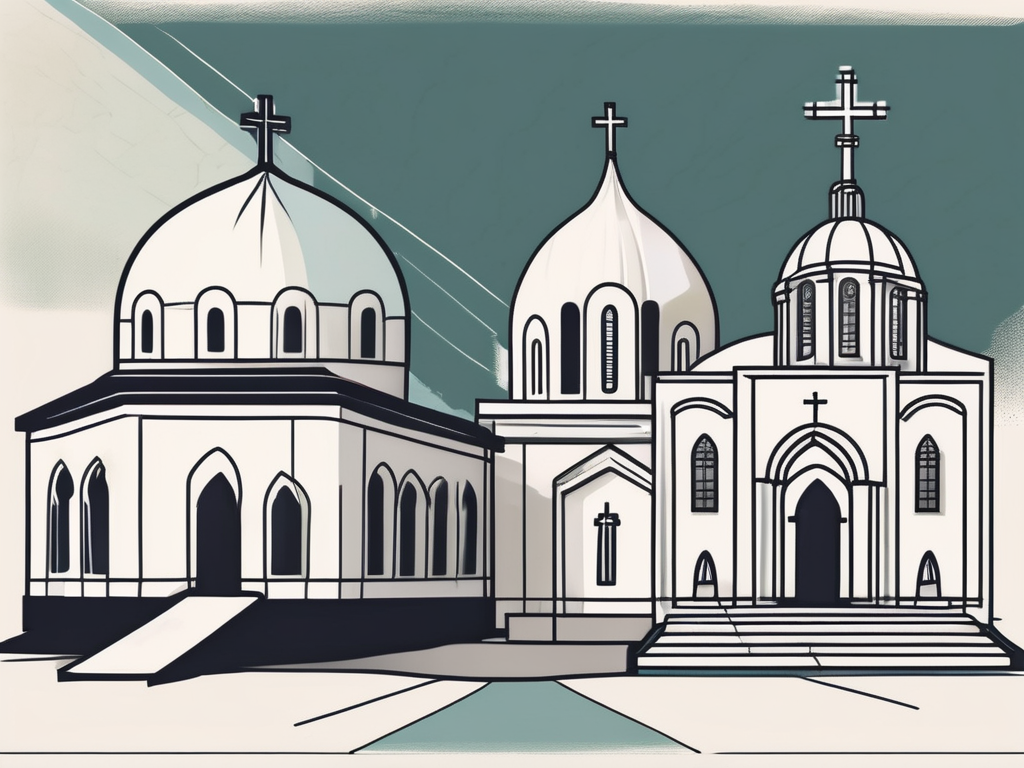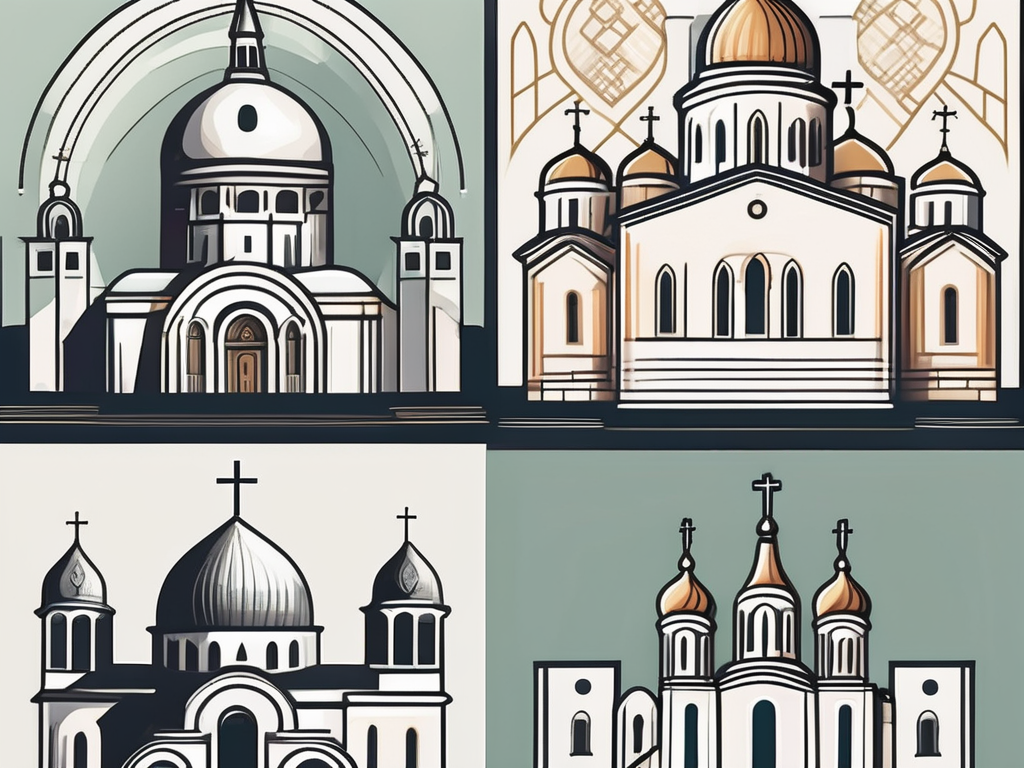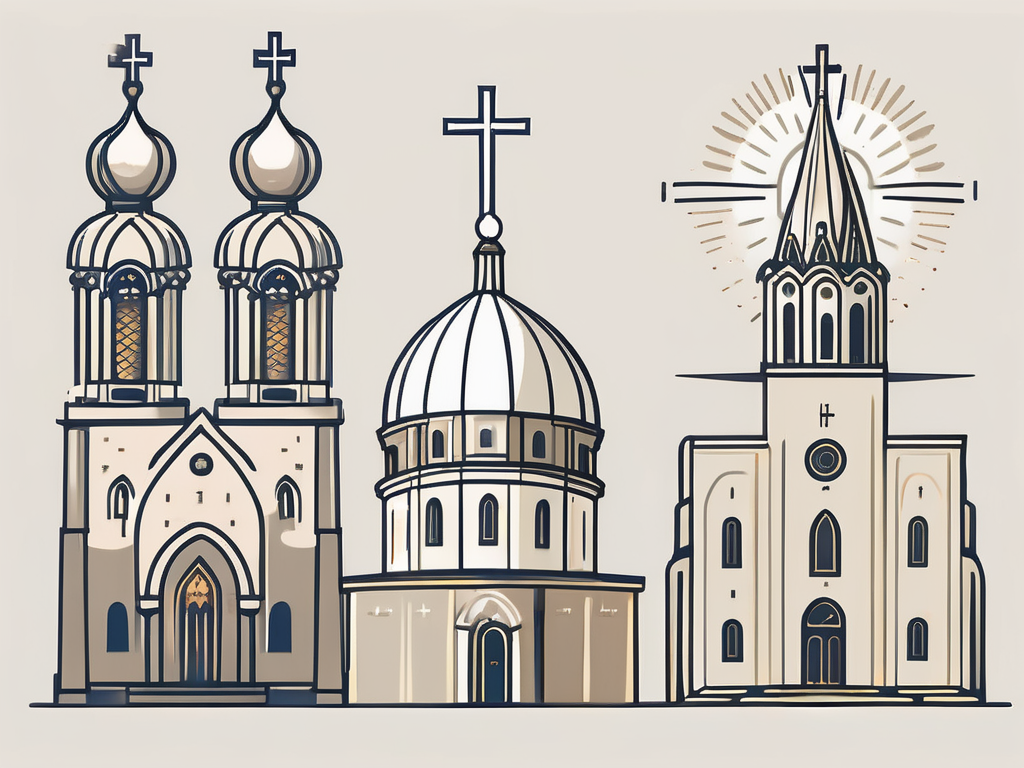In the world of Christianity, two major branches stand out: Eastern Orthodox and Catholic. While both share similarities, they also have distinct differences that define their beliefs, practices, and traditions. Understanding these differences and similarities is key to appreciating the rich tapestry of the Christian faith.
Historical Background of Eastern Orthodox and Catholic Churches
The Eastern Orthodox Church and the Catholic Church have deep historical roots that trace back to the early years of Christianity. While they have ancient origins, they have followed separate paths throughout history, resulting in distinct identities today.
Origin and Evolution of Eastern Orthodox Church
The Eastern Orthodox Church has its roots in the early Christian community established in Constantinople, present-day Istanbul, in the 1st century A.D. It developed alongside the Byzantine Empire and emerged as the dominant Christian faith in the Eastern Roman Empire. The Byzantine Empire, with its capital in Constantinople, served as a melting pot of cultures and ideas, contributing to the rich and diverse nature of the Eastern Orthodox Church.
As the Byzantine Empire expanded its territories, the Eastern Orthodox Church’s influence grew as well. Missionaries were sent to various regions, spreading the teachings of the Church and establishing new communities of believers. This expansion led to the formation of distinct Eastern Orthodox traditions and practices in different regions, such as the Greek Orthodox Church, the Russian Orthodox Church, and the Ethiopian Orthodox Tewahedo Church.
The Eastern Orthodox Church played a significant role in shaping the political and cultural landscape of Eastern Europe. It provided a sense of unity and identity for the people, especially during times of political turmoil and foreign invasions. The Church also played a crucial role in preserving and promoting the Greek language and culture, as well as the Cyrillic alphabet used in Slavic languages.
Origin and Evolution of Catholic Church
The Catholic Church, on the other hand, traces its lineage back to the teachings of Jesus Christ and the apostles. It developed into a more structured institution under the leadership of the Bishop of Rome, also known as the Pope. The Pope served as the spiritual head of the Church, providing guidance and authority to the faithful.
During the early centuries of Christianity, the Catholic Church faced numerous challenges and controversies. It had to navigate through theological debates, such as the nature of Christ and the role of the Virgin Mary. These debates led to the formulation of key doctrines and dogmas, which continue to shape the beliefs and practices of the Catholic Church today.
The Catholic Church’s influence expanded throughout Western Europe, particularly during the Middle Ages. It played a central role in the development of medieval society, providing education, healthcare, and social services. Monastic orders, such as the Benedictines and Franciscans, emerged as important institutions within the Church, contributing to the preservation of knowledge and the advancement of arts and sciences.
The Catholic Church also played a significant role in the exploration and colonization of the New World. Missionaries were sent to the Americas, Africa, and Asia, spreading Christianity and establishing new Christian communities. This expansion led to the formation of distinct Catholic traditions and practices in different regions, such as the Latin Rite, the Maronite Church, and the Syro-Malabar Catholic Church.
Today, both the Eastern Orthodox Church and the Catholic Church continue to be influential religious institutions, with millions of followers worldwide. While they share many similarities in terms of their beliefs and practices, they also maintain distinct identities shaped by their unique historical trajectories and cultural contexts.
Fundamental Beliefs and Practices
Despite their different historical paths, both the Eastern Orthodox and Catholic Churches share fundamental beliefs and practices that form the core of their faith.
The Eastern Orthodox Church, with its rich history and deep-rooted traditions, upholds a set of core doctrines that guide its followers in their spiritual journey. At the heart of their belief system is the Holy Trinity, the belief in one God who exists in three distinct persons: the Father, the Son (Jesus Christ), and the Holy Spirit. This profound understanding of the nature of God forms the foundation of their faith.
In addition to the belief in the Holy Trinity, the Eastern Orthodox Church places great emphasis on the divinity of Jesus Christ. They firmly believe that Jesus is not merely a prophet or a teacher, but the Son of God who took on human form to redeem humanity from sin. This belief in the divinity of Jesus is central to their understanding of salvation.
Salvation, according to the Eastern Orthodox Church, is achieved through a combination of faith and good works. They believe that faith in Jesus Christ is essential for salvation, but it must be accompanied by a life of righteousness and good deeds. This emphasis on the importance of both faith and works sets the Eastern Orthodox Church apart in its understanding of salvation.
Another significant aspect of the Eastern Orthodox Church’s faith is the sacraments. They believe that the sacraments are visible signs of God’s grace and are essential for the spiritual growth and nourishment of the believers. Among the sacraments, the Eucharist or Holy Communion holds a special place. It is seen as the mystical participation in the body and blood of Christ and is considered the most profound and intimate encounter with God.
Furthermore, the Eastern Orthodox Church places great importance on prayer and fasting as spiritual disciplines. Prayer is seen as a means of communing with God and seeking His guidance and blessings. Fasting, on the other hand, is viewed as a way to discipline the body and focus the mind on spiritual matters. These practices are deeply ingrained in the Orthodox tradition and are considered essential for spiritual growth and transformation.
Core Doctrines of Catholic Church
The Catholic Church, with its rich history spanning centuries, shares many core doctrines with the Eastern Orthodox Church. These doctrines serve as the bedrock of the Catholic faith and guide its followers in their spiritual journey.
In addition to the core beliefs shared with the Eastern Orthodox Church, the Catholic Church places a particular emphasis on the authority of the Pope. The Pope, as the successor of Saint Peter, is seen as the visible head of the Church and the supreme authority in matters of faith and morals. This belief in the Papal authority sets the Catholic Church apart from other Christian denominations.
Another distinctive aspect of the Catholic faith is the sacrament of confession. Catholics believe in the power of confession, where believers confess their sins to a priest and receive absolution. This sacrament is seen as a means of receiving God’s forgiveness and reconciling with Him and the Church.
The intercession of saints is also an important aspect of the Catholic faith. Catholics believe that the saints, who have lived exemplary lives of holiness, can intercede on behalf of the faithful and pray for their needs. This belief in the intercession of saints is deeply rooted in the Catholic tradition and is seen as a source of comfort and inspiration for believers.
Overall, both the Eastern Orthodox and Catholic Churches share a common foundation of fundamental beliefs and practices. While they may have their distinct traditions and practices, their core doctrines unite them in their faith in the Holy Trinity, the divinity of Jesus Christ, and the importance of salvation through faith and good works. These beliefs, coupled with the sacraments, prayer, fasting, the authority of the Pope, confession, and the intercession of saints, form the rich tapestry of their respective faiths.
The Role of Clergy and Laity
In both the Eastern Orthodox and Catholic Churches, there is a clear distinction between the roles of the clergy and the laity within the community of believers.
Hierarchical Structure in Eastern Orthodox Church
The Eastern Orthodox Church follows a hierarchical structure centered around the bishop, with archbishops, metropolitans, and patriarchs in positions of authority. The clergy, including deacons and priests, play a vital role in leading the faithful through the sacraments and spiritual guidance.
Within the Eastern Orthodox Church, the bishop holds a position of great significance. As the overseer of a diocese, the bishop is responsible for the spiritual well-being of the local community of believers. They are seen as the successors of the apostles and are entrusted with the task of preserving the teachings and traditions of the early Church.
Archbishops, metropolitans, and patriarchs are higher-ranking bishops who oversee larger regions or specific jurisdictions within the Eastern Orthodox Church. They provide guidance and support to the bishops under their authority, ensuring the unity and coherence of the Church as a whole.
Deacons, on the other hand, assist the bishops and priests in their pastoral duties. They are ordained ministers who serve the Church in various capacities, such as assisting in the liturgy, distributing the Eucharist, and engaging in acts of charity and service to the community.
Priests, ordained by the bishop, are responsible for the day-to-day spiritual care of the faithful. They lead the worship services, administer the sacraments, and provide pastoral guidance to individuals and families. Priests are seen as mediators between God and the people, offering prayers and intercessions on behalf of the community.
Hierarchical Structure in Catholic Church
The Catholic Church also follows a hierarchical structure, with the Pope serving as the supreme authority. The clergy, comprising bishops and priests, assist in the administration of the sacraments and the pastoral care of the faithful. Additionally, the Catholic Church has a rich tradition of religious orders dedicated to various ministries.
The Pope, considered the successor of Saint Peter, is the Bishop of Rome and the head of the Catholic Church. He is regarded as the Vicar of Christ on Earth and has the authority to teach, govern, and sanctify the faithful. The Pope is responsible for upholding and interpreting the teachings of the Church, ensuring its unity and guiding its mission in the world.
Bishops, appointed by the Pope, are the shepherds of their respective dioceses. They are responsible for the spiritual well-being of the faithful within their jurisdiction, overseeing the administration of the sacraments, promoting social justice, and providing pastoral care. Bishops are seen as the successors of the apostles and are entrusted with the task of preserving the apostolic tradition.
Priests, ordained by the bishop, serve as co-workers with the bishop in the pastoral ministry. They celebrate the Eucharist, administer the sacraments, preach the Word of God, and provide spiritual guidance to the faithful. Priests are called to imitate Christ in their lives and to be servants of the people, offering them the grace and love of God.
Religious orders within the Catholic Church are communities of men and women who dedicate themselves to a particular charism or mission. These orders, such as the Franciscans, Dominicans, and Jesuits, have a rich history of service in various areas, including education, healthcare, social work, and missionary work. Members of religious orders take vows of poverty, chastity, and obedience, committing themselves to a life of prayer, community, and service.
In conclusion, both the Eastern Orthodox and Catholic Churches have a hierarchical structure that distinguishes the roles of the clergy and the laity. The clergy, including bishops, priests, deacons, and members of religious orders, play essential roles in leading and serving the faithful, while the laity contributes to the life of the Church through their active participation and witness in the world.
Liturgical Differences and Similarities
Both the Eastern Orthodox and Catholic Churches place great importance on liturgical worship, although their styles and practices differ in various ways.
Worship Style in Eastern Orthodox Church
The Eastern Orthodox Church is known for its rich and elaborate liturgical worship, often characterized by immersive sensory experiences. The divine liturgy, celebrated in ancient and solemn rituals, incorporates chanting, incense, and the veneration of icons.
Worship Style in Catholic Church
The Catholic Church also values liturgical worship but with a broader spectrum of worship styles. While some Catholic liturgies echo the grandeur of Eastern Orthodox worship, others may focus on simplicity and accessibility. Catholic worship often includes hymns, prayers, scripture readings, and the Eucharist.
Iconography and Sacred Symbols
Both the Eastern Orthodox and Catholic Churches employ visual representations, such as icons and symbols, to convey spiritual truths and provide a focal point for devotion.
Significance of Icons in Eastern Orthodox Church
Icons hold a significant place in Eastern Orthodox worship and spirituality. They are regarded as windows to the divine, helping believers connect with the saints and mysteries of the faith. Icons often depict Christ, the Virgin Mary, and various saints, and they are venerated through prayer and kissing.
Significance of Symbols in Catholic Church
The Catholic Church also values the use of symbols, although it places less emphasis on icons compared to the Eastern Orthodox Church. Symbols such as the crucifix, the Eucharistic bread and wine, and the cross carry profound spiritual meaning and act as reminders of key aspects of the Catholic faith.
In conclusion, the Eastern Orthodox and Catholic Churches share a common foundation in Christianity while embracing distinct traditions and practices. While it is important to understand the differences that separate these two branches, it is equally important to appreciate their shared beliefs and mutual reverence for Christ. Through dialogue, respect, and a commitment to the pursuit of truth, Christians across these denominations can grow in unity and understanding.












